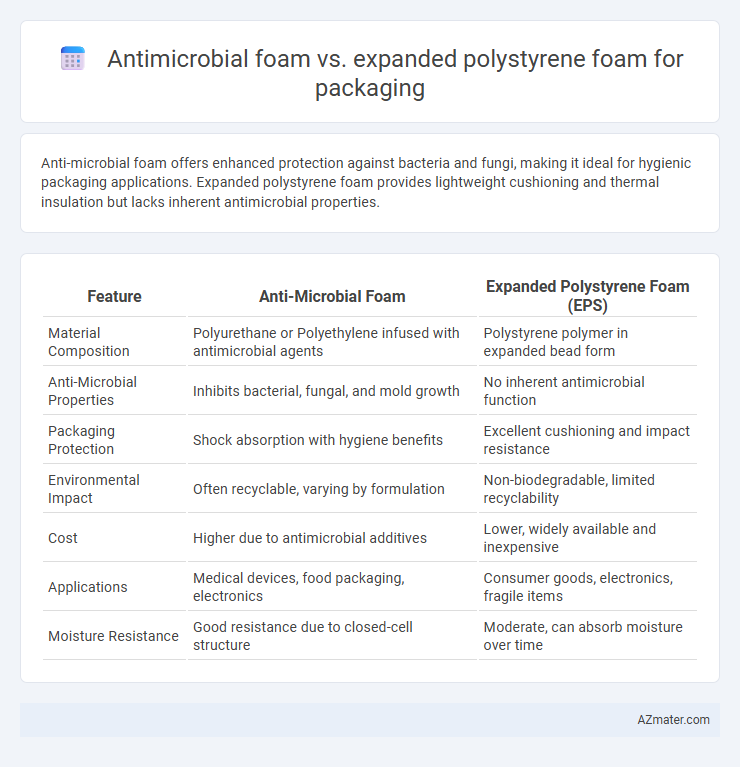Anti-microbial foam offers enhanced protection against bacteria and fungi, making it ideal for hygienic packaging applications. Expanded polystyrene foam provides lightweight cushioning and thermal insulation but lacks inherent antimicrobial properties.
Table of Comparison
| Feature | Anti-Microbial Foam | Expanded Polystyrene Foam (EPS) |
|---|---|---|
| Material Composition | Polyurethane or Polyethylene infused with antimicrobial agents | Polystyrene polymer in expanded bead form |
| Anti-Microbial Properties | Inhibits bacterial, fungal, and mold growth | No inherent antimicrobial function |
| Packaging Protection | Shock absorption with hygiene benefits | Excellent cushioning and impact resistance |
| Environmental Impact | Often recyclable, varying by formulation | Non-biodegradable, limited recyclability |
| Cost | Higher due to antimicrobial additives | Lower, widely available and inexpensive |
| Applications | Medical devices, food packaging, electronics | Consumer goods, electronics, fragile items |
| Moisture Resistance | Good resistance due to closed-cell structure | Moderate, can absorb moisture over time |
Introduction to Packaging Foams
Packaging foams such as anti-microbial foam and expanded polystyrene foam (EPS) play critical roles in product protection and contamination prevention during storage and transport. Anti-microbial foam incorporates agents that inhibit the growth of bacteria and fungi, enhancing hygiene for sensitive products such as medical devices and food items. Expanded polystyrene foam offers lightweight cushioning and thermal insulation, widely used for fragile goods but lacks inherent antimicrobial properties, making it less suitable for sterile or hygienic environments.
Overview of Anti-Microbial Foam
Anti-microbial foam enhances packaging by inhibiting the growth of bacteria, mold, and fungi, ensuring product safety and longevity in industries such as food, pharmaceuticals, and electronics. This foam integrates antimicrobial agents into its cellular structure, providing continuous protection against microbial contamination without compromising cushioning performance. Compared to expanded polystyrene foam, anti-microbial foam offers superior hygiene benefits while maintaining lightweight and shock-absorption properties essential for delicate or perishable goods.
Features of Expanded Polystyrene (EPS) Foam
Expanded Polystyrene (EPS) foam offers exceptional lightweight cushioning and shock absorption, making it ideal for protecting fragile items during transportation. Its moisture resistance and thermal insulation properties extend product shelf life and guard against environmental damage. EPS foam is also highly cost-effective and recyclable, supporting sustainable packaging solutions in various industries.
Key Differences Between Anti-Microbial and EPS Foams
Anti-microbial foam incorporates biocidal agents that inhibit bacterial and fungal growth, offering enhanced hygiene for sensitive packaging applications compared to expanded polystyrene (EPS) foam, which lacks inherent antimicrobial properties. EPS foam is lightweight, rigid, and thermal insulating, making it ideal for protecting fragile goods but is more susceptible to microbial accumulation and environmental degradation. The key differences lie in anti-microbial foam's ability to maintain sterile conditions, contrasting with EPS's durability and cost-effectiveness for standard protective cushioning in packaging.
Anti-Microbial Properties and Their Importance
Anti-microbial foam offers superior protection against microbial contamination compared to expanded polystyrene foam, making it ideal for packaging perishable goods and sensitive electronics. Its inherent biocidal agents inhibit the growth of bacteria, fungi, and mold, ensuring product safety and extending shelf life. This microbial resistance is critical in industries such as food, pharmaceuticals, and healthcare, where maintaining hygiene and preventing contamination are paramount.
Durability and Strength Comparison
Anti-microbial foam exhibits enhanced durability due to its resistance to microbial degradation, maintaining structural integrity longer than expanded polystyrene (EPS) foam. EPS foam, while lightweight and cushioning, is more prone to cracking and crumbling under stress, reducing its overall strength and lifespan in packaging applications. The molecular structure of anti-microbial foam provides superior tensile strength and resilience, making it a more robust option for protecting sensitive products during transport.
Environmental Impact: Sustainability and Recycling
Anti-microbial foam often integrates biocidal agents that can complicate recycling processes and contribute to environmental toxicity, whereas expanded polystyrene (EPS) foam, despite being lightweight and effective for insulation, presents significant challenges due to its low biodegradability and limited recycling infrastructure. Expanded polystyrene foam is widely criticized for its persistence in landfills and marine environments, leading to long-term ecological damage, while anti-microbial foams may pose additional risks through chemical leaching during disposal. Sustainable packaging trends prioritize materials with closed-loop recycling systems and reduced ecological footprints, favoring innovations that enhance EPS recyclability or develop biodegradable alternatives to traditional foam.
Cost Analysis: Anti-Microbial vs EPS Foam
Anti-microbial foam typically incurs higher upfront costs compared to expanded polystyrene (EPS) foam due to the incorporation of specialized antimicrobial agents during manufacturing. EPS foam, known for its low production expenses and widespread availability, remains a more cost-effective choice for mass packaging applications. However, the long-term savings from reduced product contamination and extended shelf life with anti-microbial foam can offset the initial price difference in specific industries such as food and medical packaging.
Safety and Regulatory Considerations
Anti-microbial foam offers enhanced safety by inhibiting bacterial growth, reducing contamination risks in packaging applications, which is crucial for healthcare and food industries. Expanded polystyrene foam, while widely used for cushioning, poses challenges due to its flammability and potential environmental hazards, prompting stricter regulatory scrutiny under agencies like the EPA and FDA. Compliance with international safety standards, such as ISO 22196 for antimicrobial efficacy and ASTM E84 for fire resistance, is essential when selecting packaging materials to ensure product protection and regulatory adherence.
Choosing the Right Foam for Your Packaging Needs
Antimicrobial foam offers enhanced protection against bacterial and fungal growth, making it ideal for packaging food, medical devices, or electronics requiring sanitation and durability. Expanded polystyrene (EPS) foam provides excellent cushioning and insulation at a lower cost, suitable for fragile items and temperature-sensitive shipments. Selecting the right foam depends on your product's sensitivity to contamination, budget constraints, and the need for moisture resistance or temperature control.

Infographic: Anti-microbial foam vs Expanded polystyrene foam for Packaging
 azmater.com
azmater.com